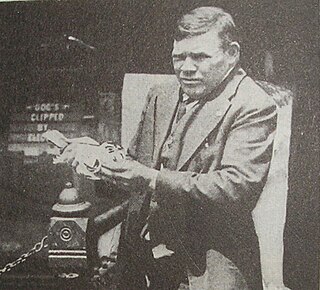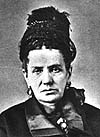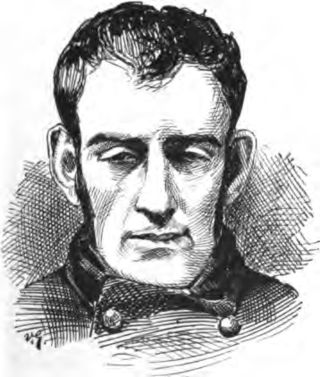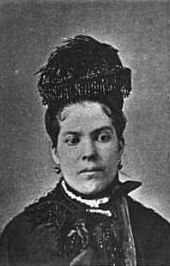
The Lenox Avenue Gang was an early 20th-century New York City street gang led by Harry Horowitz; it was considered one of the most violent gangs of the pre-Prohibition era. It was based in Harlem in Upper Manhattan, New York City, around 125th Street, in what was then a predominantly Jewish neighborhood.

The Gopher Gang was an early 20th-century New York street gang who counted among its members Goo Goo Knox, James "Biff" Ellison, and Owney Madden, born in England of Irish ancestry. Based in the Irish neighborhood of Hell's Kitchen, the Gopher Gang grew to control most of Manhattan with their territory covering Fourth to Forty-Second Street and Seventh to Eleventh Avenue.

Edward Coleman was the founder of the Forty Thieves, alleged to be the oldest criminal gang in New York City and the first Irish gang with an established leader. He became one of New York City's most notorious villains, for the murder of his wife and popular Five Points character known as "The Pretty Hot Corn Girl".

Thomas "Humpty" Jackson was a New York criminal and last of the independent gang leaders in New York's underworld during the early twentieth century. Reportedly well read, Jackson was said to be an admirer of such writers such as Voltaire, Charles Darwin, Leonard Huxley and Herbert Spencer as well as various Greek and Latin texts. He was, however, known to be a violent man who regularly carried three revolvers, including one in his derby hat and another secreted in a strange-looking small sweaty holster under his hunchback.

Fredericka "Marm" Mandelbaum operated as a criminal fence to many of the street gangs and criminals of New York's underworld, handling between $1–5 million in stolen goods between 1862 and 1884. Like her principal rival John D. Grady and the Grady Gang, she also became a matriarch to the criminal elements of the city and was involved in financing and organizing numerous burglaries and other criminal operations throughout the post-American Civil War era.
"Dandy" Johnny Dolan was a New York City murderer and reputed leader of the Whyos street gang.

"Black" Lena Kleinschmidt was a German-born New York criminal who, as a prominent jewel thief during the late 19th century, was an associate of fence Fredericka "Marm" Mandelbaum and Adam Worth. Among others in Mandelbaum's "clique", she and con artist Sophie Lyons served as protégés early in their careers of shoplifting and pick pocketing.

Margaret Brown was a New York criminal and thief during the late 19th century. She was most widely known under the name Old Mother Hubbard, after the nursery rhyme of that name, which was popular at the time. Among her aliases she also included the surnames Young and Haskins. She was one of the most well-publicized female thieves in the United States during the mid-to late 19th century and was part of Marm Mandelbaum's "inner circle" which included other notorious women such as Big Mary, Sophie Lyons, Queen Liz and Lena Kleinschmidt.

Ellen Clegg was a New York criminal specializing in pick pocketing and shoplifting. A close associate of Fredericka Mandelbaum, she was well known to authorities in several major cities along with her husband James "Old Jimmy" Clegg and had an extensive arrest record. She was arrested with Tilly Miller, "Black" Lena Kleinschmidt and four other shoplifters in Boston on December 6, 1876; her picture taken by the Boston Police Department for the "Rogues' Gallery". She was later arrested in the city for pick pocketing two years later and sent to the House of Correction.
Eliza Wallace, also known as Big Mary or Boston Mary, was a New York criminal during the late 19th century. Her known aliases included Eliza Gilford, Mary Anderson, and Mary Rogers. An associate of Fredericka Mandelbaum, she was a prominent thief and con artist in New York's underworld during the 1860s and 1870s.
Queen Liz was the pseudonym of an American thief and pickpocket who was a prominent member of New York's underworld during the mid-to late 19th century. She was among the elite "inner circle" of female career criminals under Marm Mandelbaum during the 1860s and 1870s. Among these included fellow thieves, blackmailers and confidence women such as Lena Kleinschmidt, Sophie Lyons, Kid Glove Rosey, Little Annie, Big Mary and Old Mother Hubbard, all of whom were regular guests at her extravagant dinner parties.
The Bowe Brothers were a criminal family in New York City during the early-to-mid-19th century. The gang was headed by Martin Bowe, owner of the Catherine Slip sailors' home Glass House, and included Jack, Jim and Bill Bowe. All were well-known shooters, cutters and thieves in New York's Fourth Ward and often led waterfront thugs in raids on dockyards and ships anchored in the East River. The brothers were also fences and disposed of money obtained by other waterfront gangs.
Hester Jane Haskins or Jane the Grabber was an American madam, procuress, and underworld figure in New York City during the 1860s and 1870s. The main rival of Red Light Lizzie, she owned and operated several "houses of ill fame" as well being a chief supplier of prostitutes to bordellos, brothels, and similar establishments throughout the city. She employed a small group of "respectable-looking men and women", numbering a dozen or so, who traveled New England luring young women with promises of exciting jobs back in New York. Once these women arrived, they were abducted and forced to work in her or her clients' establishments.
Ephraim Snow or Old Snow was an American criminal fence and underworld figure on New York City during the early-to mid-19th century. He was one of the first major fences in New York and the main competitor of Joe Erich during the 1850s and 60s, however the two had a far more friendly and cooperative relationship then the fierce rivalries of later fences such as John D. "Traveling Mike" Grady and Fredericka "Marm" Mandelbaum. He operated from a small dry goods store on the corner of Grand and Allen Streets, only a short distance from Erich's establishment in Maiden Lane, and was well known as a dealer in "stolen property of every description". According to underworld lore, Erich once disposed of a flock of sheep that some Bowery thugs brought back with them while on vacation in Upstate New York having stolen them from a farm in Westchester County and herded them "through the streets of the city to the shop of the fence".

Rosanna Peers (?-1840) was an American criminal fence and underworld figure in New York City during the early-to mid 19th century. She is the earliest known business owner to begin actively dealing with the city's emerging underworld and whose Centre Street grocery store and dive bar, established in 1825 just south of Anthony Street, was used as the longtime headquarters of the Forty Thieves upon their formation by Edward Coleman in 1826.

Michael "Sheeny Mike" Kurtz was an American burglar and gang leader in New York City during the mid-to late 19th century. He was one of the co-founders of the Dutch Mob, along with Little Freddie and Johnny Irving, during the 1870s. Kurtz and the others controlled the area between Houston and 5th Streets for several years until the gang was driven out by "strong-arm squads" under Captain Anthony Allaire in 1876. A year later he was arrested in Boston for robbing a silk house owned by Scott & Co. and sentenced to 12 years imprisonment. It was while in prison that he discovered that eating common soap could produce the effect of ill health. His sudden and unexplainable weight loss and other symptoms baffled the prison doctors and he was able to fool officials that he was dying and received a pardon.
Tom Flaherty, more commonly known under his pseudonym Old Flaherty, was an American criminal, sneak thief and river pirate in New York City during the mid-to late 19th century. He was the patriarch of a criminal family in New York's Seventh Ward which terrorized the New York waterfront in the post-American Civil War era. Flaherty was described as having "long white whiskers and a benevolent smile, but he was one of the most cruel thugs of the Seventh Ward".
Thomas Hadden was American saloon keeper, criminal and underworld figure in New York City's infamous Fourth Ward during the mid-to late 19th century. He was the owner of a Cherry Street dive bar, a popular underworld hangout located next to Dan Kerrigan's place, and co-led the Dead Rabbits with Kit Burns. For over 25 years, his Water Street boarding house was one of the most notorious "crimp houses" on the New York waterfront as thousands of sailors were shanghaied, robbed or murdered. Hadden, and contemporaries such as Bill Slocum or John Allen, exercised considerable political influence in the city and were generally able to receive protection from city officials throughout their criminal careers.

"Little" Annie Reilly (1844-unknown), also known under the aliases Kate Cooley, Connelly and Manning, was a 19th-century American thief and con artist widely regarded as "the cleverest woman in her line in America". A well-known member of New York's underworld, she was part of an elite "inner circle" of female career criminals under Marm Mandelbaum during the 1860s and 1870s. These included some of the most notorious thieves, blackmailers and confidence women in the country such as Lena Kleinschmidt, Sophie Lyons, Kid Glove Rosey, Queen Liz, Big Mary and Old Mother Hubbard,











